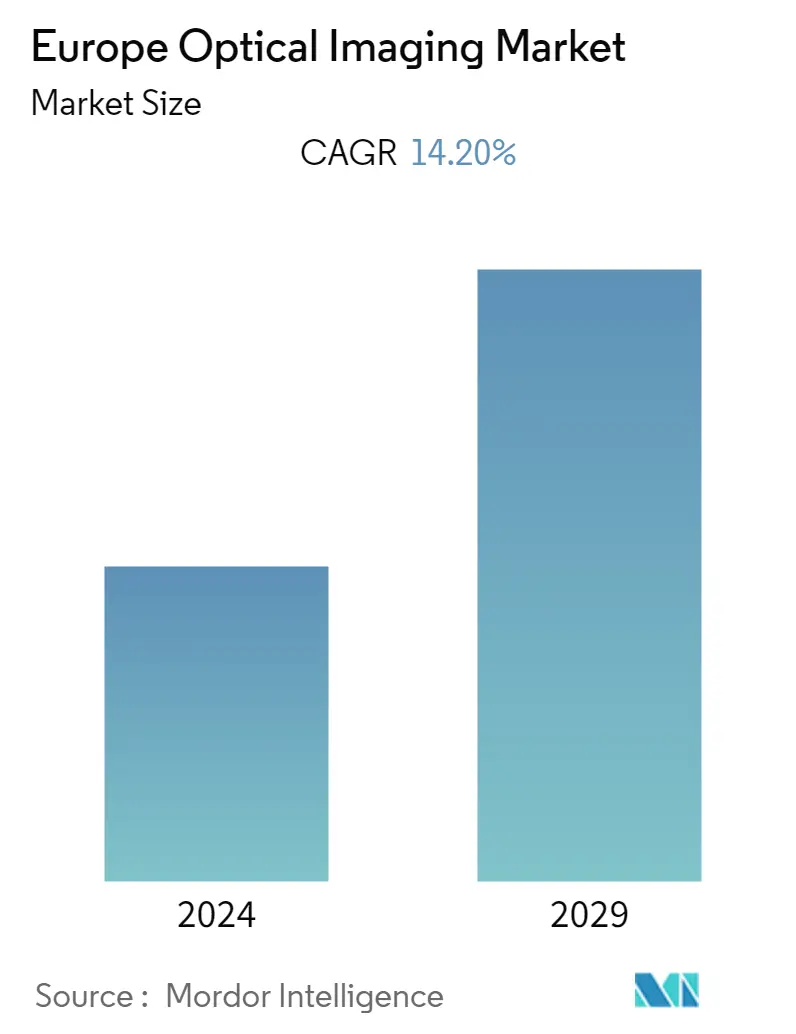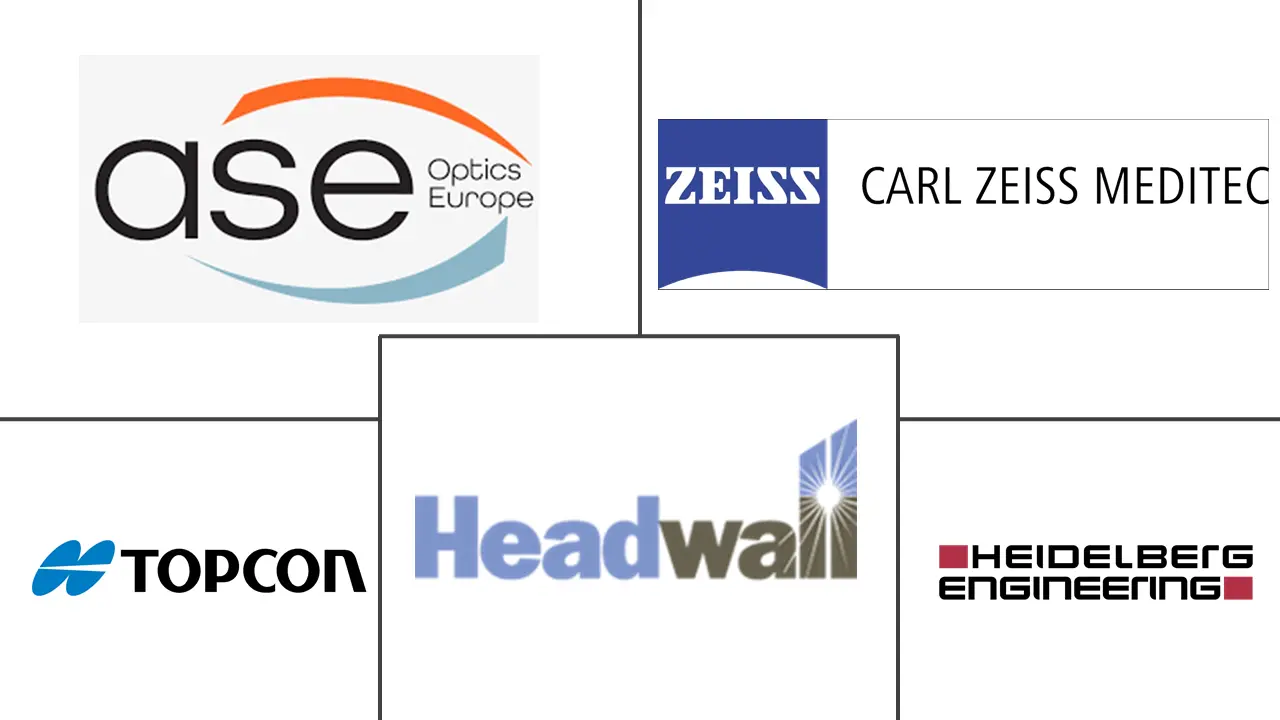Market Size of Europe Optical Imaging Industry

| Study Period | 2019 - 2029 |
| Base Year For Estimation | 2023 |
| Forecast Data Period | 2024 - 2029 |
| Historical Data Period | 2019 - 2022 |
| CAGR | 14.20 % |
| Market Concentration | Medium |
Major Players
*Disclaimer: Major Players sorted in no particular order |
Europe Optical Imaging Market Analysis
Europe Optical Imaging Market is expected to register a CAGR of 14.2% during the forecast period (2021-2026). The growing prevalence of eye disorders, increased focus on medical device research and development, adoption of modern healthcare technologies, and an increasing aging population contribute to the growth of the optical imaging market.
- The increasing trend of collaborations and partnerships between companies in the region to leverage their technical expertise and manufacturing infrastructure to innovate sophisticated products is expected to drive the market.
- For instance, in November 2021, OmniVision Technologies Inc., a developer of advanced digital imaging solutions, and Diaspective Vision GmbH, developer of high-quality hyperspectral and multispectral camera systems for medical applications, partnered to develop an advanced endoscopic camera, the Malyna system, which is based on proprietary multispectral imaging technology. Malyna delivers indocyanine green (ICG) based perfusion visualization and acts as a platform to adapt further algorithms for quantified perfusion and tissue categorization without the necessity of color agent injection. The system augments a 4K live video stream with physiological information to provide surgeons with objective decision-making support.
- Further, GE Healthcare and Affidea, a pan-European company operating in advanced diagnostic imaging, outpatient, and cancer care services, signed a multi-year agreement to deploy imaging and digital technologies across the Affidea network. GE Healthcare will install over 200 pieces of new equipment in Affidea's network of centers across Europe. The agreement includes the provision of 60 new MRIs, 50 ultrasound devices, 40 CT scanners, and 30 X-rays machines by 2022.
- However, hefty instrument costs, stringent regulatory approval procedures, a scarcity of qualified operators, and insufficient reimbursements for optical imaging procedures restrain the growth of the studied market. Further, due to the COVID-19 pandemic, many imaging and diagnostic departments have experienced a rapid decline in optical imaging case volumes due to the increased need for social distancing among patients, physicians, and other healthcare professionals.
- Additionally, the prevalence of alternative technologies like Raster scan optoacoustic mesoscopy (RSOM), an imaging technology developed as part of the EU-funded INNODERM project, makes it possible to capture detailed vascular and cellular structures under the skin surface and precisely analyze changes of the skin, which isn't possible with optical imaging as it doesn't provide sufficient contrast or depth penetration to obtain comparable information, could act as a market restraint.
Europe Optical Imaging Industry Segmentation
The Europe Optical Imaging Market is segmented by Technology (Photoacoustic Tomography, Optical Coherence Tomography, Hyperspectral Imaging, Near-Infrared Spectroscopy), Product (Imaging Systems, Illumination Systems, Optical Imaging Software, Optical Imaging Software), Application Areas (Ophthalmology, Oncology, Cardiology, Dermatology, Neurology), Application (Pathological Imaging, Intraoperative Imaging), End-User Industry (Hospitals & Clinics, Research & Diagnostic Laboratories, Pharmaceutical Industry, Biotechnology Companies), and Country.
Optical imaging is a technique that employs light and photon properties to create detailed images of organs, tissues, cells, and even molecules. The procedures provide non-invasive or slightly invasive ways to view within a body. It is used in optical microscopy, spectroscopy, endoscopy, scanning laser ophthalmoscopy, laser Doppler imaging, optical coherence tomography, etc.
| By Technology | |
| Photoacoustic Tomography | |
| Optical Coherence Tomography | |
| Hyperspectral Imaging | |
| Near-Infrared Spectroscopy | |
| Others |
| By Product | |
| Imaging Systems | |
| Illumination Systems | |
| Optical Imaging Software | |
| Cameras | |
| Others |
| By Application Areas | |
| Ophthalmology | |
| Oncology | |
| Cardiology | |
| Dermatology | |
| Neurology | |
| Others |
| By Application | |
| Pathological Imaging | |
| Intraoperative Imaging |
| By End-User Industry | |
| Hospitals and Clinics | |
| Research and Diagnostic Laboratories | |
| Pharmaceutical Industry | |
| Biotechnology Companies | |
| Others |
| By Country | |
| United Kingdom | |
| Germany | |
| France | |
| Italy | |
| Others |
Europe Optical Imaging Market Size Summary
The European optical imaging market is poised for significant growth, driven by factors such as the increasing prevalence of eye disorders, a heightened focus on medical device research and development, and the adoption of modern healthcare technologies. The aging population in Europe further amplifies the demand for advanced imaging solutions. Collaborative efforts among companies to leverage technical expertise and manufacturing capabilities are fostering innovation in the development of sophisticated optical imaging products. Notable partnerships, such as those between OmniVision Technologies Inc. and Diaspective Vision GmbH, as well as GE Healthcare and Affidea, highlight the region's commitment to advancing imaging technologies. However, challenges such as high instrument costs, stringent regulatory approvals, and a shortage of qualified operators pose constraints to market expansion.
The market is also witnessing the integration of artificial intelligence into diagnostic techniques, enhancing the capabilities of optical imaging in ophthalmology. The development of portable and handheld devices, like the Envisu C2300 OCT by Leica Microsystems, is expected to improve accessibility and expand the use of optical coherence tomography. Additionally, initiatives like the PROSCOPE project aim to innovate non-invasive cancer detection methods, further driving market growth. The presence of key players such as ASE Optics, Inc., Carl Zeiss Meditec AG, and Heidelberg Engineering Inc. underscores the competitive landscape, where companies are encouraged to leverage their technological expertise to address complex healthcare challenges and expand their market reach.
Europe Optical Imaging Market Size - Table of Contents
-
1. MARKET INSIGHTS
-
1.1 Market Overview
-
1.2 Industry Attractiveness - Porter's Five Forces Analysis
-
1.2.1 Bargaining Power of Suppliers
-
1.2.2 Bargaining Power of Consumers
-
1.2.3 Threat of New Entrants
-
1.2.4 Threat of Substitute Products
-
1.2.5 Intensity of Competitive Rivalry
-
-
1.3 Technology Snapshot
-
1.4 Assessment of the Impact of COVID-19 on the Market
-
-
2. MARKET SEGMENTATION
-
2.1 By Technology
-
2.1.1 Photoacoustic Tomography
-
2.1.2 Optical Coherence Tomography
-
2.1.3 Hyperspectral Imaging
-
2.1.4 Near-Infrared Spectroscopy
-
2.1.5 Others
-
-
2.2 By Product
-
2.2.1 Imaging Systems
-
2.2.2 Illumination Systems
-
2.2.3 Optical Imaging Software
-
2.2.4 Cameras
-
2.2.5 Others
-
-
2.3 By Application Areas
-
2.3.1 Ophthalmology
-
2.3.2 Oncology
-
2.3.3 Cardiology
-
2.3.4 Dermatology
-
2.3.5 Neurology
-
2.3.6 Others
-
-
2.4 By Application
-
2.4.1 Pathological Imaging
-
2.4.2 Intraoperative Imaging
-
-
2.5 By End-User Industry
-
2.5.1 Hospitals and Clinics
-
2.5.2 Research and Diagnostic Laboratories
-
2.5.3 Pharmaceutical Industry
-
2.5.4 Biotechnology Companies
-
2.5.5 Others
-
-
2.6 By Country
-
2.6.1 United Kingdom
-
2.6.2 Germany
-
2.6.3 France
-
2.6.4 Italy
-
2.6.5 Others
-
-
Europe Optical Imaging Market Size FAQs
What is the current Europe Optical Imaging Market size?
The Europe Optical Imaging Market is projected to register a CAGR of 14.20% during the forecast period (2024-2029)
Who are the key players in Europe Optical Imaging Market?
ASE Optics, Inc., Carl Zeiss Meditec AG, Headwall Photonics Inc., Topcon Corporation and Heidelberg Engineering Inc. are the major companies operating in the Europe Optical Imaging Market.

